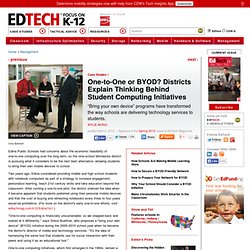

The Future of Education: BYOD in the Classroom. As children across the nation return to school, many are going armed with their own computational tools.

From laptops to tablets and smartphones, schools and universities across the globe are testing out a more dynamic learning environment, where students bring and use their choice of technologically assistive devices in the classroom. Despite the obvious benefits, the influx of mobile technology in educational systems has also provoked backlash from parents and teachers alike, similar to the BYOD backlash witnessed within enterprise IT departments in the past few years. Educational institutions are ultimately presented two options: adopt a BYOD program, embracing the technology trend, encouraging student participation, and expanding curriculum to include BYOD-driven topics, or to impose of a BYOD policy, setting rules to govern the presence and practice of these potentially disruptive devices. Welcome to the 21st Century, Parents. One-to-One or BYOD? Districts Explain Thinking Behind Student Computing Initiatives. Edina Public Schools had concerns about the economic feasibility of one-to-one computing over the long term, so the nine-school Minnesota district is pursuing what it considers to be the next best alternative: allowing students to bring their own mobile devices to school.

Two years ago, Edina considered providing middle and high school students with notebook computers as part of a strategy to increase engagement, personalize learning, teach 21st century skills and take education beyond the classroom. After running a one-to-one pilot, the district shelved the idea when it became apparent that students preferred using their personal mobile devices and that the cost of buying and refreshing notebooks every three to four years would be prohibitive. Creating a Robust and Safe BYOD Program. Until recently, student electronic devices, from cell phones to iPods to laptop computers, were the forbidden fruit in schools.

But with technology budgets languishing and such devices becoming more powerful, affordable and omnipresent in students’ lives, district technology leaders are now eyeing a welcome educational harvest through bring-your-own-device (BYOD) programs. Lucy Gray, project director of the Leadership for Mobile Learning Initiative at the Consortium for School Networking (CoSN), has studied early BYOD adopters. Mooresville School District, a Laptop Success Story.